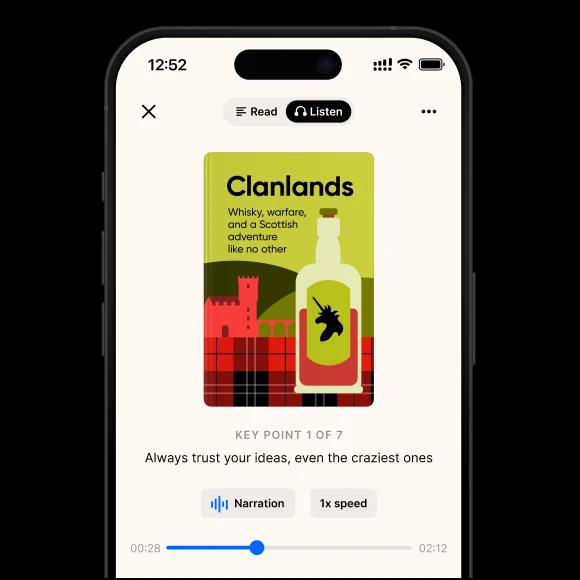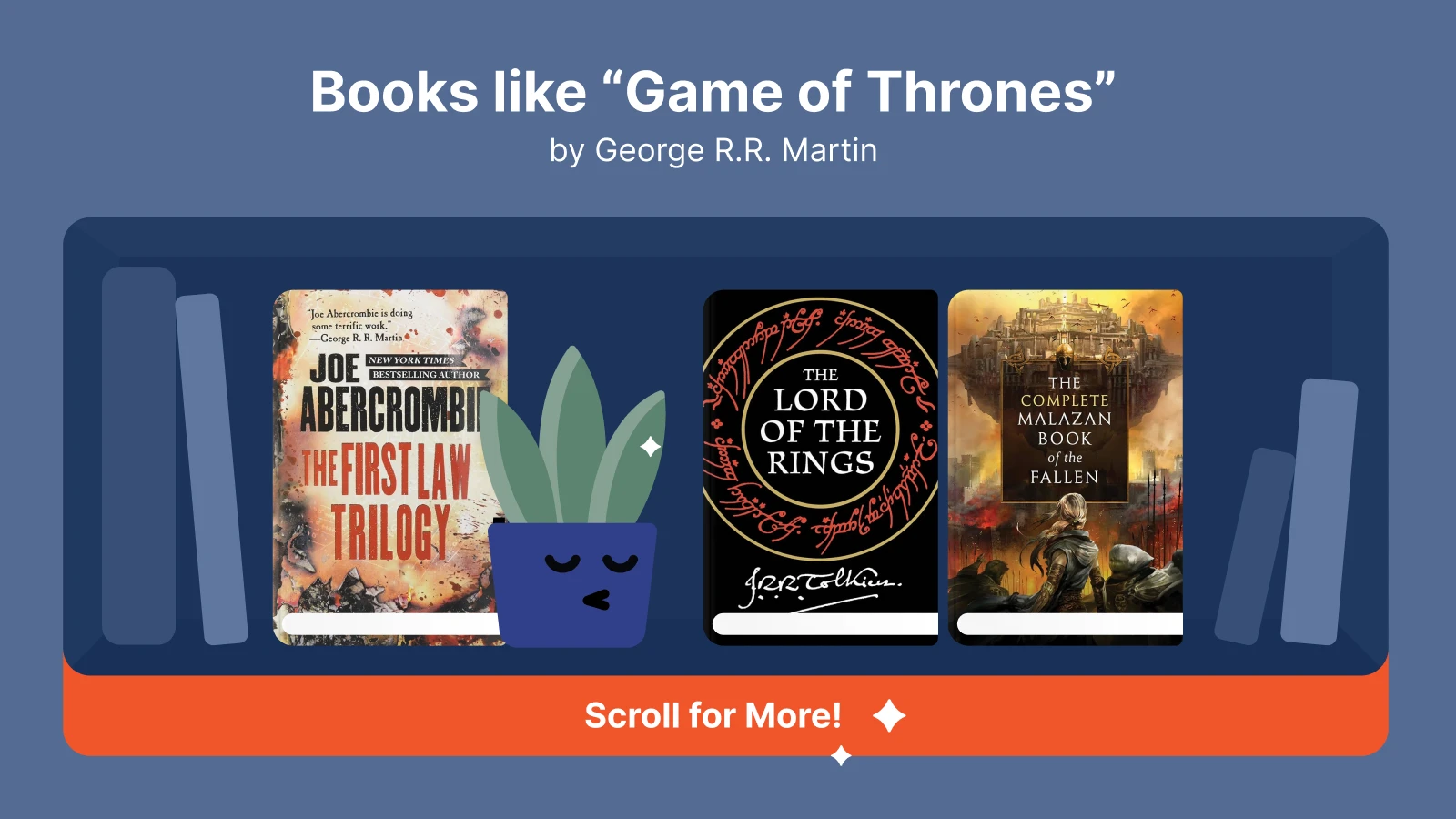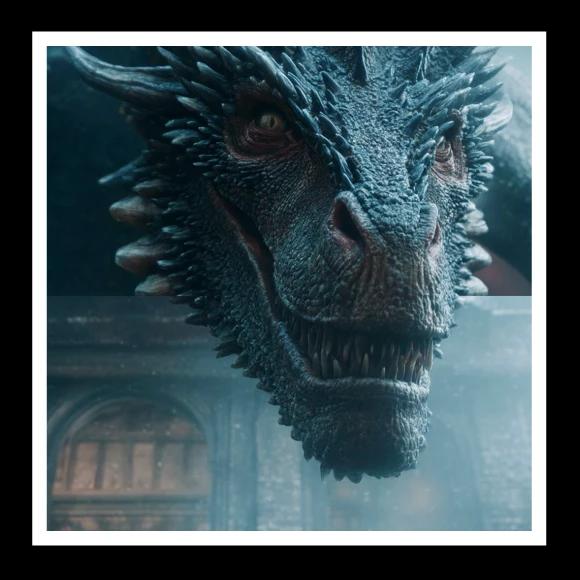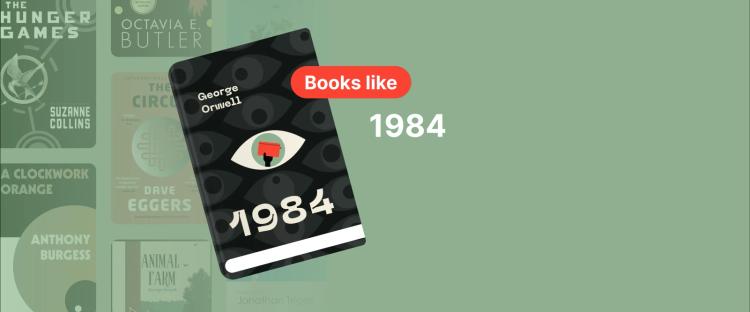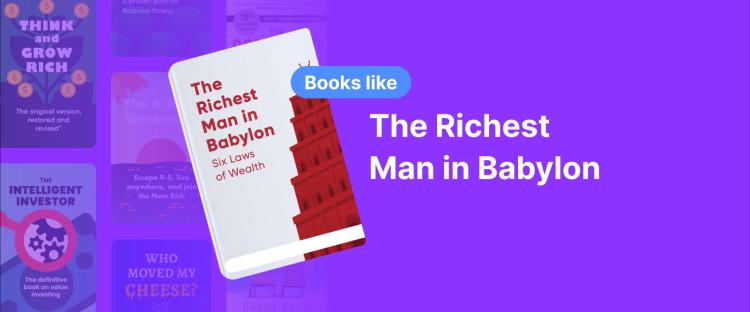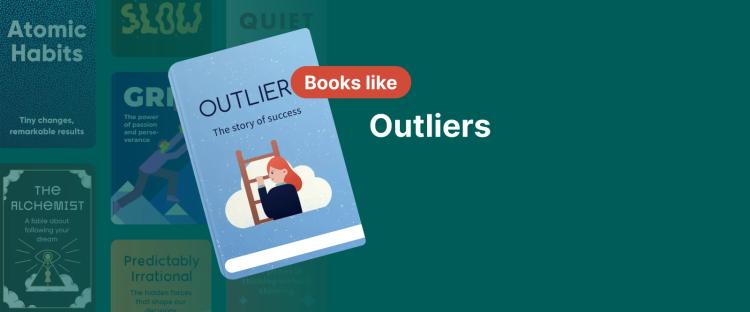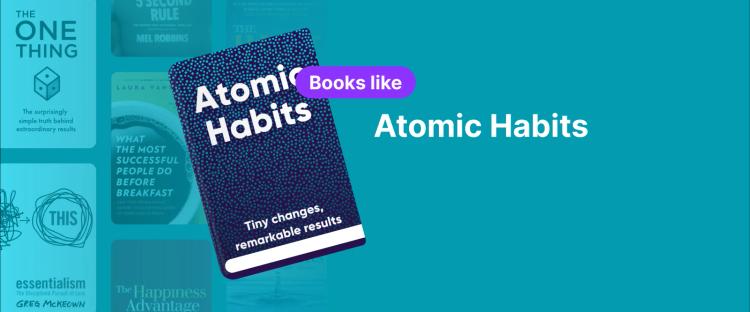We've curated the list of best books like 'A Game of Thrones' that deliver the same punch. This list includes the original epic fantasy that directly inspired Martin, as well as grimdark sagas known for their black humor and morally compromised protagonists, and other groundbreaking epics that share a similar scope and focus on warring nations.
As you prepare to dive in, get a tactical advantage. Download Headway to access 15-minute summaries of the world's best non-fiction books on self-development and psychology. You can master the themes of leadership, war, and political strategy — the very skills needed to survive Westeros — while waiting for the final battle for the Iron Throne.
Quick answer: What are the five best books like 'A Game of Thrones' to read in 2025?
'The Accursed Kings' by Maurice Druon: George R.R. Martin himself called this "The original Game of Thrones." Historical fiction with ruthless political intrigue.
'The First Law' by Joe Abercrombie: Brutal, morally complex characters and realistic warfare that rivals Martin's grimdark style.
'Memory, Sorrow, and Thorn' by Tad Williams: Ancient threats from the frozen North, political civil war in the South, and plot elements that directly inspired Game of Thrones.
'The Black Company' by Glen Cook: A significant influence on Martin's writing style, featuring morally compromised soldiers and unflinching brutality.
'The Dagger and the Coin' by Daniel Abraham: Political complexity driven by economics and finance, with the same detailed maneuvering that makes 'A Game of Thrones' so compelling.
16 book series like 'A Game of Thrones'
These book recommendations capture the spirit of George R.R. Martin's work from the first lines. Enjoy and save for later!
1. 'A Song of Ice and Fire' by George R.R. Martin
First book: 'A Game of Thrones'
The story: This series (aka ASOIAF) chronicles a power struggle among kingdoms for control of the Iron Throne. Meanwhile, ancient threats are stirring. You'll follow Jon Snow and other characters who must survive this war. But not everyone will.
Reading order: Start with 'A Game of Thrones.' Then, follow up with 'A Clash of Kings,' 'A Storm of Swords,' 'A Feast for Crows,' and 'A Dance with Dragons.' The sixth book, 'The Winds of Winter,' is not yet published.
Similarities between the books:
They reject the traditional 'good vs. evil' fantasy binary and focus on protagonists and antagonists who are deeply morally compromised, driven by self-interest and survival rather than noble ideals.
The conflicts are often not defined by magic but by intense political intrigue and succession crises.
To fully explore complex political systems, these epics utilize a vast narrative scope and a rotating structure of viewpoint characters.
2. 'The First Law' by Joe Abercrombie
First book: 'The Blade Itself'
The story: This brutal trilogy features a cynical war hero, a powerful mage, and a cripplingly narcissistic torturer. The world is filled with violence, black humor, and deeply flawed people.
Reading order: Start with 'The Blade Itself.' The following books in the main trilogy are 'Before They Are Hanged' and 'Last Argument of Kings.'
Similarities between the books:
Like the battles in Westeros, 'The First Law' trilogy presents realistic warfare where flawed characters rarely achieve clear moral victories — Joe Abercrombie's grim worldbuilding mirrors George R.R. Martin's refusal to romanticize combat.
Both epic fantasy series use multiple viewpoints, shifting between political intrigue and violent action, creating the same narrative structure that made 'A Game of Thrones' so compelling.
The protagonists in this book series are as deeply morally compromised as Jaime Lannister or Cersei — powerful players who make terrible choices for understandable reasons.
3. 'The Wheel of Time' by Robert Jordan
First book: 'The Eye of the World'
The story: This is one of the most famous and epic fantasy series of all time. It follows a group of young villagers swept into a massive conflict. They must confront ancient prophecies and powerful magic. This series has been adapted into an Amazon TV series.
Reading order: The sequence starts with 'The Eye of the World,' continues with 'The Great Hunt,' 'The Dragon Reborn,' 'The Shadow Rising,, 'The Fires of Heaven,' 'Lord of Chaos,' 'A Crown of Swords,' 'The Path of Daggers,' 'Winter's Heart,' 'Crossroads of Twilight,' 'Knife of Dreams,' 'The Gathering Storm,' 'Towers of Midnight,' and concludes with 'A Memory of Light.'
Similarities between the books:
'The Wheel of Time' matches the sheer scope and length of 'A Song of Ice and Fire.' Both fantasy series create truly epic worlds that demand commitment from readers.
Like the political failures in Westeros, Robert Jordan's fantasy novels feature complex, warring nations and shifting alliances where even the "good guys" make disastrous political mistakes that cost thousands of lives.
Both epic fantasy series use a sophisticated, rule-bound magic system tied to political power structures — the One Power functions in Jordan's world much like the rumors of dragons and prophecies shape politics in 'Game of Thrones.'
4. 'The Lord of the Rings' by J.R.R. Tolkien
First book: 'The Fellowship of the Ring'
The story: This one is the foundation of all modern high fantasy. A humble hobbit inherits a powerful, evil ring and must journey across Middle-earth to destroy it. This story is the root of the hero's journey in fantasy books.
Reading order: This trilogy starts with 'The Fellowship of the Ring.' The story continues in 'The Two Towers' and concludes with 'The Return of the King.'
Similarities between the books:
Both J.R.R. Tolkien's Middle-earth and George R.R. Martin's Westeros show a world-ending threat that powerful people ignore because of their own greed and political ambitions — the Others are coming while the kingdoms fight for the Iron Throne, just as Sauron rises while men wage war amongst themselves.
Tolkien's commitment to creating deep cultures, languages, and histories demonstrates the same meticulous worldbuilding approach that makes ASOIAF feel so real and lived-in.
Both fantasy novels involve a fellowship of diverse characters and a central artifact of power — though Martin subverts many of Tolkien's tropes, the influence of 'The Lord of the Rings' on modern epic fantasy is undeniable.
5. 'The Malazan Book of the Fallen' by Steven Erikson
First book: 'Gardens of the Moon'
The story: This immense series focuses on the Malazan Empire's decades-long military campaigns. It is known for its complexity, large cast of hundreds of characters, and deep, dark history.
Reading order: Start with 'Gardens of the Moon.' The series continues with 'Deadhouse Gates,' 'Memories of Ice,' 'House of Chains,' 'Midnight Tides,' 'The Bonehunters,' 'Reaper's Gale,' 'Toll the Hounds,' and 'Dust of Dreams.' It concludes with 'The Crippled God.'
Similarities between the books:
'The Malazan Book of the Fallen' shares ASOIAF's focus on soldiers, military strategy, and the grim reality of imperial conquest — Steven Erikson's battles feel as brutal and morally complex as the War of the Five Kings.
Like the competing claims to the Iron Throne, this epic fantasy series features gods, ascendants, and competing empires driving massive global political intrigue across multiple continents.
Both book series use a large, rotating cast of viewpoint characters — Erikson's POV structure mirrors George R.R. Martin's chapter-based approach to showing the same events from different perspectives.
6. 'The Broken Empire Trilogy' by Mark Lawrence
First book: 'Prince of Thorns'
The story: Meet Jorg Ancrath, a child prince turned brutal raider who seeks to reclaim his throne. It is a relentless story of ambition and revenge.
Reading order: The trilogy begins with 'Prince of Thorns.' The second part is 'King of Thorns, ' and the last one is 'Emperor of Thorns.'
Similarities between the books:
'The Broken Empire's' protagonist, Jorg, is a ruthless anti-hero as complex and morally twisted as Jaime Lannister or Theon Greyjoy — Mark Lawrence creates the same uncomfortable sympathy for terrible people that makes 'Game of Thrones' so gripping.
Like the succession struggles in Westeros, this fantasy series focuses on revenge, the violent inheritance of power, and how ambition corrupts everyone it touches.
Both settings blend medieval statecraft with remnants of a destroyed, technological past — 'The Broken Empire's' post-apocalyptic Europe mirrors how the ruins of Valyria haunt ASOIAF.
7. 'The Farseer Trilogy' by Robin Hobb
First book: 'Assassin's Apprentice'
The story: This character-driven series follows the life of the illegitimate son of a prince, FitzChivalry Farseer. He learned the art of assassination to be valuable for the crown.
Reading order: The Farseer Trilogy starts with 'Assassin's Apprentice.' It is followed by 'Royal Assassin' and concludes with 'Assassin's Quest.'
Similarities between the books:
Like Jon Snow's struggle at Winterfell and the Wall, Robin Hobb's fantasy novels focus heavily on court politics, duty, and the painful consequences of being born a royal bastard who can never fully belong.
Both 'The Farseer Trilogy' and ASOIAF feature outsiders whose hidden identities and abilities are critical to the kingdom's survival — Fitz's story parallels many themes in 'Game of Thrones.'
The magic system (the Skill and the Wit) in this epic fantasy series is feared and misunderstood by the populace, adding hidden danger, much like how magic is returning to Westeros, but most people refuse to believe it.
8. 'Mistborn' by Brandon Sanderson
First book: 'Mistborn: The Final Empire'
The story: In a desolate land, a tyrant rules an empire that has lasted a thousand years. A crew of criminals and rebels plans an impossible heist to overthrow him. The series is known for its unique magic system.
Reading order: The first trilogy starts with 'Mistborn: The Final Empire.' It is followed by 'The Well of Ascension' and concludes with 'The Hero of Ages.'
Similarities between the books:
Like the rebellion against the Targaryen dynasty and the ongoing fight against tyranny in Westeros, 'Mistborn' is highly focused on dismantling a complex political system through brutal violence.
Brandon Sanderson's distinct magic system (Allomancy) has deep military, political, and economic implications — the same way dragons and wildfire shape the balance of power in 'Game of Thrones.'
The ash-covered, dying land in this fantasy series creates a grim fantasy world that mirrors the dangers of the coming winter in the North — both settings ask how people survive when the world itself is hostile.
9. 'The Kingkiller Chronicle' by Patrick Rothfuss
First book: 'The Name of the Wind'
The story: Kvothe recounts his life story. It follows a great journey from a traveling performer to a student of magic and a key player in world-changing events.
Reading order: The current series starts with 'The Name of the Wind' and is followed by 'The Wise Man's Fear.' The final novel in the trilogy, 'The Doors of Stone,' is still anticipated.
Similarities between the books:
'The Kingkiller Chronicle's' framing story features a powerful, legendary hero living in humble exile — much like how Robert's Rebellion created exiled Targaryens, or how many great houses in ASOIAF hide their power and wait for the right moment.
Like the way reputation shapes politics in Westeros, Patrick Rothfuss's fantasy novels deal with the power of stories, myths, and how what people believe about you matters as much as the truth.
The detailed worldbuilding centers around a magical University that acts as a key center of learning and political intrigue — similar to how the Citadel and the maesters shape events in George R.R. Martin's world.
10. 'The Witcher' by Andrzej Sapkowski
First book: 'The Last Wish'
The story: Geralt of Rivia is a Witcher, a mutated monster hunter for hire. This dark, morally complicated world is inspired by Slavic mythology. The fantasy novels follow Geralt's journey and his deep connection to the prophesied princess Ciri.
Reading order: To understand the characters, start with the short story collections, 'The Last Wish' and 'Sword of Destiny.' Then move to the main saga, starting with 'Blood of Elves,' followed by 'Time of Contempt,' 'Baptism of Fire,' 'The Tower of the Swallow,' and 'The Lady of the Lake.'
Similarities between the books:
'The Witcher' presents a hero who is a morally gray outsider caught between kings, empires, and non-human races — just as characters in 'Game of Thrones' navigate between Starks, Lannisters, and the various factions fighting for control.
Like the political maneuvering in Westeros, this fantasy world's political landscape is filled with warring kingdoms and a powerful sorceress cabal (the Lodge) that pulls strings behind the scenes.
Both fantasy series show that monster hunting is less dangerous than human evil — the White Walkers may be terrifying, but the real threat in ASOIAF often comes from other people.
11. 'The Accursed Kings' by Maurice Druon
First book: 'The Iron King'
The story: George R.R. Martin called this title "The original Game of Thrones." It's historical fiction about the French monarchy detailing a succession crisis and the fall of the Knights Templar.
Reading order: The main sequence starts with 'The Iron King.' It is followed by 'The Strangled Queen,' 'The Poisoned Crown,' 'The Royal Succession,' 'The She-Wolf of France,' 'The Lily and the Lion,' and concludes with 'When a King Loses France.'
Similarities between the books:
Maurice Druon's historical fiction chronicles the real-world events (the Hundred Years' War) that directly inspired George R.R. Martin's War of the Roses-based political intrigue in ASOIAF — Martin himself acknowledged this debt.
Like the poisonings and betrayals in Westeros, this book series is hyper-focused on court scheming, featuring ruthless monarchs who eliminate rivals through poison, false accusations, and political marriages.
Both narratives show that no one is safe — the sudden, brutal deaths of major figures drive the plot forward in 'The Accursed Kings' just as they do in 'Game of Thrones.'
12. 'The Dagger and the Coin' by Daniel Abraham
First book: 'The Dragon's Path'
The Story: A new war is brewing, not just between kings, but between a religious organization and a financial network. Read if you want to know the story of the lowborn woman and a mercenary captain caught in the conflict.
Reading Order: The series starts with 'The Dragon's Path.' It is followed by 'The King's Blood,' 'The Tyrant's Law,' 'The Widow's House,' and concludes with 'The Spider's War.'
Similarities between the books:
'The Dagger and the Coin' drives its political intrigue through economic and financial decisions — just as the Iron Bank of Braavos shapes wars in Westeros, Daniel Abraham shows that money and trade routes matter as much as swords.
Like the diverse cast in 'Game of Thrones,' this fantasy series follows morally complex characters who face massive world events with very human flaws — no one is purely heroic or completely villainous.
The large cast and detailed political maneuvering perfectly capture the spirit of ASOIAF — both book series show how small personal decisions create continent-wide consequences.
13. 'The Prince of Nothing' by R. Scott Bakker
First book: 'The Darkness That Comes Before'
The story: A brutal and philosophical series that follows a great Holy War. The central figure is a terrifyingly intelligent prince who is possibly a religious messiah.
Reading order: The first trilogy, 'The Prince of Nothing,' starts with 'The Darkness That Comes Before.' It is followed by 'The Warrior-Prophet' and concludes with 'The Thousandfold Thought.' This one is followed by a second series, 'The Aspect-Emperor.'
Similarities between the books:
R. Scott Bakker's epic fantasy series features a relentlessly dark tone and grim outlook that matches the brutal violence of George R.R. Martin's Westeros — both refuse to look away from war's true horror.
Like how prophecy and religion shape Melisandre's actions and the faith of the Seven, this fantasy world is rich with philosophical discussions on faith, destiny, and human cruelty that add intellectual depth to the bloodshed.
Both series show characters driven by grand schemes and hidden motives — manipulation and long-term planning matter as much as battlefield prowess.
14. 'The Riftwar Saga' by Raymond E. Feist
First book: 'Magician' (often split into 'Magician: Apprentice' and 'Magician: Master')
The story: An orphaned kitchen boy named Pug becomes a magician's apprentice in the Kingdom of the Isles. When an unexpected rift opens to another world, Midkemia is invaded by the Tsurani empire, pulling Pug and his warrior friend Tomas into a massive interdimensional war. The story follows Pug's capture and growth in power in the enemy's world, while Prince Arutha fights to save his own kingdom.
Reading order: The core trilogy, which begins the entire Riftwar Cycle, starts with 'Magician.' It is followed by 'Silverthorn' and concludes with 'A Darkness at Sethanon.' While the larger cycle contains many more series, starting with these three books provides the essential foundation.
Similarities between the books:
Feist's traditional high fantasy world (Midkemia) engages in a devastating, large-scale war across multiple kingdoms — much like how the War of the Five Kings tears Westeros apart while external threats loom.
Like Jon Snow or Daenerys Targaryen discovering their true importance, the central protagonist in this epic fantasy series is an outsider (Pug) whose hidden power and destiny become key to resolving global conflict.
Both fantasy novels balance the traditional epic journey with political court intrigue and military strategy. Feist shows that winning battles requires more than magic, just as 'Game of Thrones' proves that dragons alone don't win wars.
15. 'The Black Company' by Glen Cook
First book: 'The Black Company'
The story: Prepare for the story of the Black Company, a legendary mercenary unit. The first novel finds them in service to The Lady, a powerful and ruthless sorceress who rules a vast, tyrannical empire. The story is told through the cynical narrative of Croaker. He is the Company's annalist and surgeon, detailing the gritty, messy reality of war from the perspective of the common soldier fighting for the side of evil.
Reading order: The main saga begins with the first trilogy, The Books of the North: 'The Black Company,' followed by 'Shadows Linger,' and concluded by 'The White Rose.' These are then followed by The Books of the South and Glittering Stone.
Similarities between the books:
'The Black Company' is considered a direct influence on George R.R. Martin's "grimdark" style — both fantasy series focus on moral relativism and unflinching brutality rather than heroic quests.
Like the sellswords and soldiers in 'Game of Thrones,' these protagonists are morally compromised anti-heroes who are primarily survivors, not noble knights — they fight for whoever pays.
The narrative uses focused POV chapters (Croaker's Annals) to ground massive, epic events in a personal, cynical perspective — the same technique that makes ASOIAF's multiple viewpoint structure so effective.
16. 'Memory, Sorrow, and Thorn' by Tad Williams
First book: 'The Dragonbone Chair'
The story: Set on the continent of Osten Ard, this is the story of Simon, a naive scullion in the High King's castle who is thrust into a world of political intrigue and ancient magic after the death of the aged King John. Under the sway of a malevolent priest named Pryrates, King John's son, Elias, throws the realm into civil war just as the ancient, elf-like Norn race, led by the terrifying Storm King, begins their invasion from the frozen North.
Reading order: The core trilogy consists of three books: 'The Dragonbone Chair,' 'Stone of Farewell,' and 'To Green Angel Tower.' (The paperback version is split into two separate volumes: 'To Green Angel Tower: Part 1' and 'To Green Angel Tower: Part 2.')
Similarities between the books:
Both 'Memory, Sorrow, and Thorn' and 'Game of Thrones' feature an ancient, supernatural race emerging from a distant, icy northern territory to threaten the lands of men. The Storm King's Norns directly inspired George R.R. Martin's White Walkers.
Tad Williams splits his central hero's journey into elements that ASOIAF adapts across multiple characters. Jon Snow and other protagonists in Westeros echo different aspects of Simon's transformation.
Like how the fight for the Iron Throne distracts from the real threat Beyond the Wall, both epic fantasy series show that political power struggles in the South blind human kingdoms to the true, existential danger gathering in the North.
Level up your mind with Headway
These fantasy worlds are thrilling, but the real-world wisdom behind them comes from non-fiction. If you're ready to stop reading about brilliant strategists and start thinking like one, download Headway. This app delivers the core insights from the world's best books on leadership, psychology, and strategic thinking in 15-minute summaries.
You can learn the actual principles of crisis management and persuasion — the very skills Tyrion Lannister and Littlefinger used to change the course of history — without committing years to another massive series. Also, you can enjoy thousands of bestselling books directly on our website — just visit the Fiction section or browse our main library page to choose the next title.
Headway is where you keep your mind sharp and your reading list under control — all on your own terms.
Frequently asked questions about books like 'A Game of Thrones'
What genre does 'Game of Thrones' fall under?
'Game of Thrones' belongs to the epic fantasy genre, often called "grimdark" for its morally gray characters and political intrigue. It blends elements of medieval history, mythology, and complex power struggles in a realistic, often brutal world. This is one of the reasons why this genre is so often filmed.
Do I need to read 'A Song of Ice and Fire' before 'Fire and Blood'?
Not necessarily. 'Fire and Blood' is a standalone history of House Targaryen, set centuries before 'A Game of Thrones.' You can read just this book if you want. However, reading 'A Song of Ice and Fire' first gives more context and emotional depth to the Targaryen legacy.
Which books correspond to 'Game of Thrones'?
Each season of the HBO series roughly adapts one book from George R.R. Martin’s 'A Song of Ice and Fire.' The first season corresponds to 'A Game of Thrones,' followed by 'A Clash of Kings,' 'A Storm of Swords,' 'A Feast for Crows,' and 'A Dance with Dragons.'
What era is closest to 'Game of Thrones'?
The setting mirrors late medieval Europe (14th–15th centuries). Many events, like the War of the Roses, directly inspired the political conflicts, feudal loyalties, and dynastic rivalries of Martin's world. If you are fascinated by history, check out our library of historical books.
What age is 'Fourth Wing' appropriate for?
'Fourth Wing' by Rebecca Yarros is generally recommended for readers aged 18 and up. It contains mature themes, violence, and romantic scenes suited to adult audiences rather than younger teens. In some US states and other countries, this content may be allowed for those 16 years of age or older.
What is high fantasy?
High fantasy is a subgenre set in entirely fictional worlds with their own laws, histories, and magic systems. It often features grand themes like heroism, destiny, and the battle between good and evil — as seen in 'The Lord of the Rings' and 'A Game of Thrones.'


